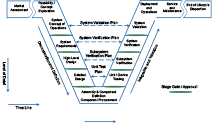 There is a lot happening on the topic of Model-Based Systems Engineering (MBSE) at the moment. The annual INCOSE event in Torrance, which featured an MBSE workshop, and the recent publication of the Aerospace & Defense PLM Action Group's position paper [download here] on Model-Based Systems Engineering Data Interoperability to name just a couple of examples. The importance of MBSE is one of the reasons that it will be a featured topic at CIMdata's upcoming 2019 PLM Market & Industry Forum—we at CIMdata hope that you will join us to learn more about this topic. Let's get started with the blog!
There is a lot happening on the topic of Model-Based Systems Engineering (MBSE) at the moment. The annual INCOSE event in Torrance, which featured an MBSE workshop, and the recent publication of the Aerospace & Defense PLM Action Group's position paper [download here] on Model-Based Systems Engineering Data Interoperability to name just a couple of examples. The importance of MBSE is one of the reasons that it will be a featured topic at CIMdata's upcoming 2019 PLM Market & Industry Forum—we at CIMdata hope that you will join us to learn more about this topic. Let's get started with the blog!
The widespread digitalization of discrete product development processes combined with the ever-increasing complexity of today’s cyber-physical systems is increasing focus on connecting and managing the digital thread of data and models from the early conceptual systems design to the downstream functions more typically managed within the scope of PLM.
The exponential increase in the use of software and electronics has added a great deal of complexity to today’s cyber-physical products and systems, including now “systems of systems” in the interconnected universe of the Industrial Internet of Things (IIoT) and Industry 4.0. This complexity demands that product development organizations move away from traditional stage-gate and document-centric processes and increasingly rely on agile and digital model-based processes that encompass all aspects of systems lifecycle design from initial requirements definition through in-service use and re-use/retirement. However, with this increased systems complexity, product engineering teams now face new design and performance challenges. For example, undesirable system-level behaviors can emerge due to cross-domain interactions that may not be adequately understood by any one individual or functional domain of the product development teams (i.e., mechanical, electrical/electronics, software, controls, materials, chemistry, etc.). Systems can now be defined by hundreds or even thousands of requirements and include tens of thousands of individual components with tens of millions of lines of embedded software. These complex solutions have a much higher risk of failure due to the complex interactions of the system elements and the associated potential failure modes—many of which are not obvious and/or adequately addressed by engineering teams today, even with the use of digital models. The old adage of “we don’t know what we don’t know” is even more relevant to the design of today’s complex products and systems.
An emerging opportunity related to this challenge is the application of Artificial Intelligence (AI), machine learning, and deep learning technologies. These relatively new applications are having a significant business impact in many areas outside of systems engineering today but that is changing rapidly. There is growing recognition that these new technologies can be applied in concert with advanced physics-based and statistical modeling and simulation (M&S) technologies such as robust design, multi-disciplinary analysis and optimization (MDAO) and uncertainty quantification (UQ). Today these technologies are being applied as early as the conceptual systems development phase to dramatically augment human intelligence in a digital model-based process. These technologies can also be applied to the tsunami of real-world product performance data that is becoming available from in-service physics-based digital twins in the IIoT. Several thought leaders are now using the term Augmented Intelligence to define this synergistic collaboration of human and machine intelligence.
Finally, one of the greatest challenges to enabling digital transformation and the digital thread is integrating the myriad of different engineering models and data silos that exist today in requirements definition/management solutions and conceptual systems architecture design solutions employed outside of any formal enterprise data management and collaboration platforms used to enable PLM strategies.
CIMdata will highlight the changes underway in the integration of these heretofore largely disconnected domains. This includes a discussion of the relevant industry standards and identifying emerging smaller companies that we believe will most strongly impact the level of collaboration required to design, develop, manufacture, and operate today’s complex cyber-physical systems at its upcoming 2019 PLM Market & Industry Forum events, which this year will take place in Ann Arbor MI on April 4; Frankfurt, Germany on April 11; Pune, India on April 15; Beijing, China on April 19, and Tokyo, Japan on April 24.
Key takeaways from the discussion on this topic will include:
- The complexity of today’s cyber-physical systems requires a true systems thinking approach that optimizes product performance across multiple engineering domains.
- Underutilized M&S technologies such as robust design/MDAO/UQ as well as new technologies such as AI and machine learning will be increasingly used in a model-based engineering approach to augment human intelligence and deal with systems complexity.
- There is a growing awareness that the upfront systems design process and its data must be better integrated with traditional downstream design engineering, manufacturing and even in-service operations and managed via enterprise innovation platforms.
- As manufacturing and services companies attempt to deal with the complexities of enterprise digitalization and enabling the digital thread across the entire lifecycle, the need for process change and education of the workforce will be inevitable and critical to success. Engineering best practices implementation and training services should be a high growth area.
Don







